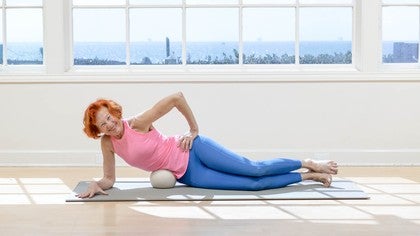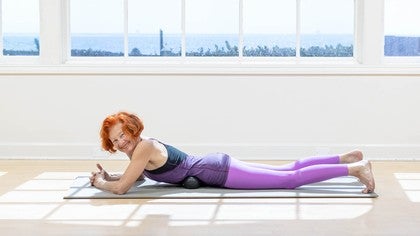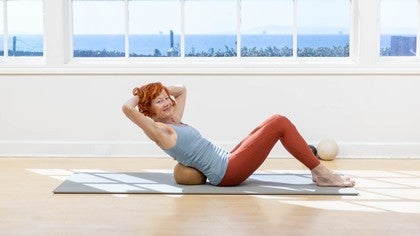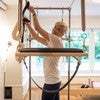Description
Props Needed: White or Black Yamuna USA® Ball or something equilvent
About This Video
Transcript
Read Full Transcript
Welcome to rolling out the iliacus and psoas. These muscle groups are deep muscles. They're very intimate. They can cold a lot of pain or tension and tightness. And they're not on the surface.
We don't actually see them. There's nothing externally that we show the world, you could say. And, yet, they are key for our posture. They connect the upper body and the lower body. And to be honest, this is kind of where a lot of psychological issues can be locked up, you could say, in that we have a pain.
I can't stomach this. I have a pain in my stomach when I hear this news. In our language, we have a built-in association to the emotional aspect of what our shaping is. So we will be gentle. If I can invite you, pay attention, listen, and adjust.
Give yourself time to allow the balls to settle into your body. I will be working with a black ball, because I've done this work a lot. And I'm quite lean. Some people find it, when they use a small ball, they don't get into their body or their physiology. So very often, a bigger ball communicates better.
So experiment and explore with what works for you. There's no-one-it-size-fits-all. But for sure, they make a difference. The iliacus, or iliopsoas is a muscle that attaches inside the pelvis, below the surface muscle. You could think of this area like a bowl.
And you're trying to get into that area. If you think of the top of the crest of this pelvis, we're looking to kind of snuggle into that area, and then move down and attach to the inside of our femur bone, quite close to the top. It is a hip flexor muscle. There's a variety of muscles that connect with hip flexors. And it also affects the external rotation of our leg.
So great muscle to release. Changes the shape sometimes. And we will start. First of all, get the ball on your hip bone. So starting out on the hip bone.
So you can feel that area. And then roll to the right. So now you have rolled into the space inside the bone. And take a moment to settle into this area and sink in. I will often just put my head down and start to press into this area.
And first of all, just take some breaths so I get in touch with what's going on here. Big breath in, breath out. And as the body starts to release, you want to feel the ball snuggling into the inside of the bone there. And you can take your pelvis and lengthen it around. So you are lengthening your tailbone around to create more traction.
You can also roll your hips a little bit to the left and to the right, to connect into the texture of that muscle. And see if you can get more in touch with it. Very often, you're not getting right onto the muscle band, but you are in the vicinity. And that starts to send messages and communication into the area. So take one more breath in, breath out, sink in, wrap the pelvis around, feel the ball go deeper into that area on the inside.
You're like a ball inside of a little shape. And drag your body forward so you are moving down. You're still pressing the ball into that inside area of the pelvis. If you like, you can imagine the ball widening the front of the pelvis, that bowl-like shape and area. The ball now should be closer to the groin area between the pelvis and the pubic bone.
But your focus is into the pelvis. You're still widening the hip bone from the inside. You're pushing it out. And you're lengthening down. So take a moment.
Breathing in any congestion, any tightness, any holding patterns released. Get the leg, the right leg, the toes hooked under. And you can lengthen the heel away to create more traction into this area. Remember, the muscle goes from the inside of the pelvis onto your femur bone. So when you lengthen the bone, you are starting to create a tractioning in the tissue.
You're letting the hip flexors open and lengthen. And if you allow the pelvis and the tail to get even longer, you ask that muscle to open up and release. Take one more breath in, breath out, and drag yourself through the groin. And now you are onto your femur bone on the inside. So take a moment here.
Feel the connection. Feel the tractioning of it. If you want, you can externally rotate your femur bone to allow the pressure to get even more to where the attachment is. Feel into this area. Let it lengthen out.
Lengthen the whole waist area as well, helps get that traction feeling. And then come on off and we'll go to the other side. So grabbing the pelvis, settling into the bone of the pelvis to begin with. Take a breath in. And on the out-breath, roll inside.
So now you're stimulating the inside of the pelvic bone. You are sinking into the abdominal area and looking to snuggle the bone right into the pelvic area on the inside. Take a breath in and wrap the left hip bone around the ball to create more depths. You can roll the pelvis all the way in the direction of the floor to snuggle the ball more deeply into this area. And then when you even the pelvis back, so both hip bones face the floor, imagine the ball literally widening the pelvis a bit.
You can take the leg and already start to lengthen it out slightly. Take a breath in. On the out-breath, drag the body further forward. Keep the ball snuggled into the pelvic area. And it moves down in the direction of the groin.
Take a moment to settle here. If you like, you can come down on the floor. You can take the tail area and the pubic bone area, and lengthen them downwards slightly. Roll the pelvis slightly to the left, back to center, and drag yourself further forward. So now you are coming into the femur bone area.
So feel into that area. You're tractioning the bone, lengthening it out of the hip, you could say, getting into where the attachment is on the inside. If you like, you turn the femur bone out to get even deeper into this area. Take a breath in. And on the out-breath, lengthen the heel away, feel that tractioning into this area, and feel into the texture of the muscles.
What's happening in your hip flexors? What's happening in your legs? See if you can find any residual tension or tightness, and move into it, iron it out. Let it have a new shape. Free it up from any patterns of sitting that we all suffer from in our lifestyle.
We have chronic tight hip flexes because we all sit so much in chairs. Take another breath in, breath out, roll a little bit further down, and then come out of the position. And we'll move into our psoas muscle as our next section of the hip flexor complex. Psoas connects to the inside of the spine. It's like if you went through the abdomen to the front of the spine below the abdominal muscles and the organs, it connects into the vertebrates, little bit into to the back ribs, and then comes through and connects into the inside of our femur really high up.
So a little bit higher than the iliacus does. So we will start at the groin, roll up, and then roll back down, and into the femur bone on both sides. We'll start on the groin area of the right side. So you want to be feeling your pubic bone, the groin area, and your thigh bone. So you want to be aware of this whole triangular area.
And from here, when you take your breath in, feel yourself tractioning your whole spinal column away from this area. So you are grabbing this hip flexor complex area and you are allowing the rest of the body to lengthen out. As you breathe out, drag yourself. Hold on a minute. You'll drag yourself a little bit down and in towards the side of the spine.
This is where it gets interesting. You want to let yourself sink and wrap around the ball. So we are penetrating the surface muscles and attempting to go deeper. Take a breath in, breath out. You are on top of the pubic bone.
You rolled off the pubic bone into the abdominal area. Let the body sink and wrap around the muscles, wrap around the bones. I'm sorry, what am I saying? Wrap around the ball. And then from here, drag yourself down and allow the ball to move up.
So we're coming close to the naval area on the side. So we're staying on the side of the spine. Take a breath, breath out, let yourself sink. This can be intense for people. A lot is going on in this area.
Try to soften. If it's very difficult, don't go deep at first. Literally, push the belly out. So you're rejecting the ball. And then slowly, as you breathe out, let yourself sink around the ball.
So you control how much the ball goes in. It takes time. Don't be abusive. Allow yourself to gradually soften the tissue. There's no rush.
This is a process of restoring health. And it takes time. One more breath in. Roll further up. You are on the side of the naval.
Take a moment to receive the ball. Sink a little bit more. Check that the sacrum is long. And then one more time, breath in. As you breathe out, move further up.
So you're under the diaphragm. Take a breath in here. Breath out. And now start to traction down again. So I'm pulling my body up.
The ball is moving down. Again, a breath in and a breath out, dragging further forward. As you do this, you may feel a rush of heat, because you're opening up a lot of circulation. Even a flush of heat into the legs really can change things in a beautiful way. One more time, breath in, breath out, and drag yourself further forward.
Roll all the way up to the groin. Take a moment here. Allow the body to receive the balls. Wait. This one can be very pensive. And again, breath in.
And on your out-breath, drag yourself through the groin, into the inside of your femur bone area. So we're cradling the bone pretty high up near the groin. This is where the psoas attaches. So take a moment. Feel into this area. Let the muscle soften.
Let the pelvis soften. And then when you feel that you've had enough, I like to roll a little bit further just to send the message of length through the tissue. And then let's come back and go on to the left side. So starting out, the ball will be in the area of the side of the pubic bone in the groin area. Take a moment to settle in.
Let the tissue soften and receive the ball. Big breath in here. And on the out-breath, start to sink yourself downwards. So you're moving down and the ball has moved up into the abdomen. So you are above the pubic bone area on the left side.
Think of the fact that you're traversing in the front of the spinal column, getting in touch with this area. If it's a lot, you can relax down, and just focus in with the sheer relaxation. Just lying on your belly, lying on a ball starts to shift so much. Take another breath in. On the out-breath, drag yourself further down.
So the ball is coming up. It's close to the spine below the naval area. Take another breath in, breath out, and drag yourself further up. This can start to be sensitive. Take your time.
Each of us has our own pacing of this work. If it's very intense for you, please learn the routine. And then do it with your own rhythm, your own time. Take two, three minutes even to really acclimatize yourself to being on the balls. Also revisit the routine more than once, because every time it gets easier and better, the body does open.
Another breath in, breath out, moving up above the naval, below the diaphragm. Take a moment to settle and lengthen. A lot can be going on here. And another breath in. And on the out-breath, drag yourself forward again.
In this position, start to feel how you are lengthening the front body away from the ball. Let the ball penetrate. Breath in and drag the body further forward and sink down. Let the softness start to go deeper in. As we learn what is going on, there's a lot deeper traction that is available.
And again, breath in, lengthen the ribs away, breath out, and drag yourself further forward. So you are coming into the space, close to the groin at the side of the pubic bone. Take a moment here. We're really coming into where the muscles are more, in the surface of the hip flexor complex. You want a lot of length here.
Nice place to stretch the ribs away from the hips. Take another breath in, breath out, and roll further through the groin and into the front, inside of the femur. So you want to feel how you cuddle into this area. And whatever you are experiencing, see, just wait. Just let the muscles release.
Let the legs start to lengthen out of the pelvis. It wants to release. That's the beauty of our body. The body does want to release. It wants to let go of a pattern and replace it with a better pattern.
So when the opportunity presents itself, there is definitely a upgrading that starts to happen. And as I mentioned, you can feel a lot of heat, a lot of sometimes pulling, tearing that sounds bad, but it's really the fascia shifting its texture, and, of course, pressure. So pay attention, because you're changing. One more time, breath in, breath out, rolling through, and then coming up to a seated position. And take a moment and see what you feel like.
See what the body feels like. Sometimes, there's a rush in the head. Sometimes, there's release in the hips. Sometimes, the lower back releases. So just notice what you notice and especially start to observe what it's like when you walk, because you will feel quite different.
Enjoy, and thank you very much.
Release Your Fascia: Upper Body Freedom
Comments
You need to be a subscriber to post a comment.
Please Log In or Create an Account to start your free trial.















